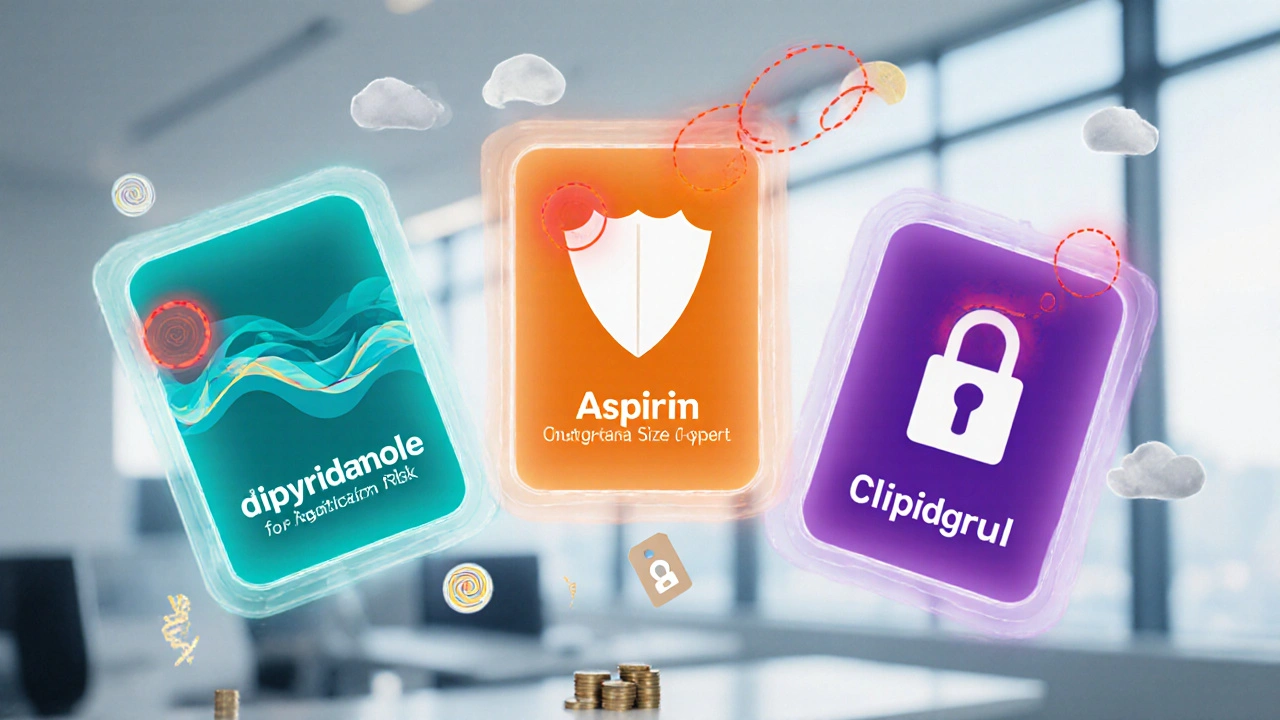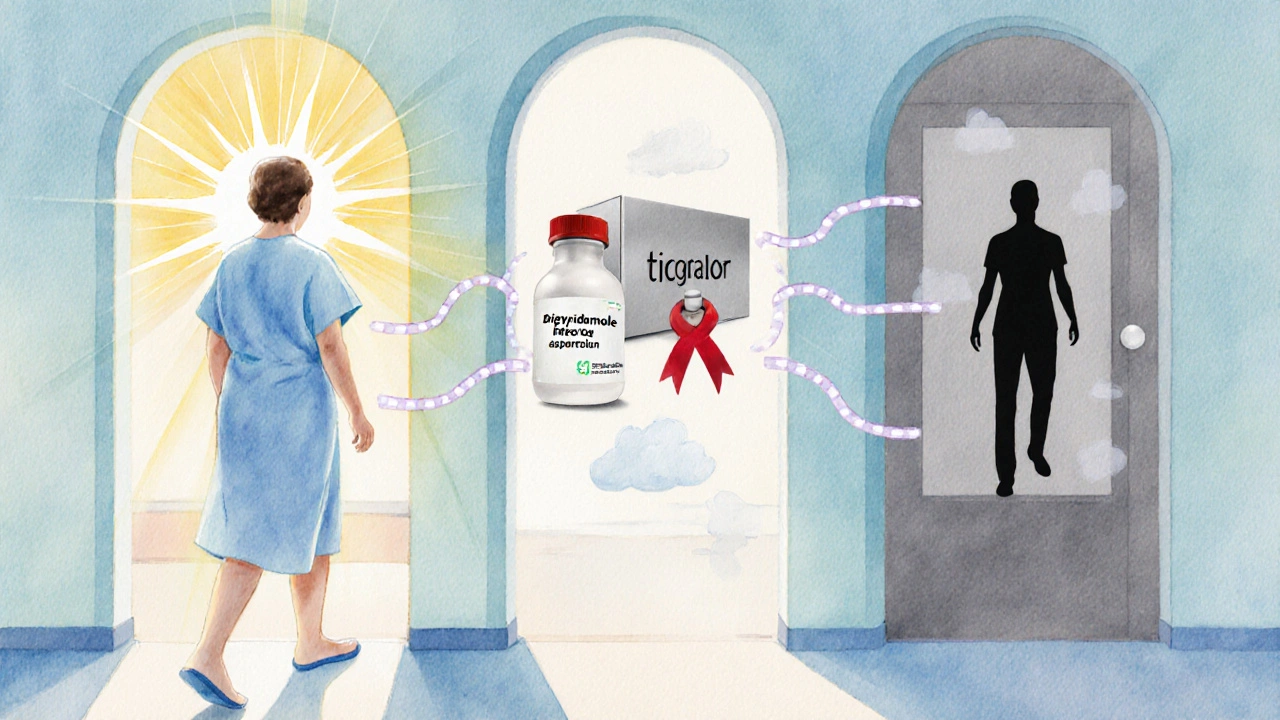Dipyridamole vs. Other Antiplatelet Drugs
Dipyridamole
Mechanism: Increases cAMP and adenosine
Use: Stroke prevention with aspirin
Side Effects: Headache, dizziness, GI upset
Cost: ~$0.60/day
Aspirin
Mechanism: Inhibits COX-1
Use: First-line for most patients
Side Effects: Gastritis, bleeding, allergies
Cost: ~$0.05/day
Clopidogrel
Mechanism: Blocks P2Y12 ADP receptor
Use: Aspirin intolerance, PAD
Side Effects: Bruising, rare TTP
Cost: ~$0.30/day
Ticagrelor
Mechanism: Reversible P2Y12 inhibitor
Use: ACS, off-label stroke
Side Effects: Shortness of breath, bleeding
Cost: ~$2.50/day
Warfarin
Mechanism: Vitamin K antagonist
Use: AFib, mechanical valves
Side Effects: Dietary interactions, INR monitoring
Cost: ~$0.07/day
Prasugrel
Mechanism: Potent thienopyridine
Use: PCI patients
Side Effects: Significant bleeding risk
Cost: ~$1.20/day
Key Decision Points
- Stroke Prevention: Dipyridamole + aspirin best for carotid disease
- Acute Events: Ticagrelor or prasugrel for rapid platelet inhibition
- Cost-Conscious Care: Aspirin or dipyridamole preferred
- Drug Interactions: Watch for caffeine/theophylline effects with dipyridamole
- Monitoring Needs: Warfarin requires regular INR checks
Did you know that a single daily pill of dipyridamole can cut stroke risk by up to 30% when paired with aspirin? That number makes physicians pause and ask: is dipyridamole the right choice for my patient, or should I reach for a newer antiplatelet agent?
TL;DR
- Dipyridamole works by boosting blood‑platelet cAMP, unlike aspirin’s COX‑1 inhibition.
- It shines in preventing strokes for patients with carotid artery disease when combined with aspirin.
- Clopidogrel and ticagrelor provide stronger platelet inhibition for acute coronary syndromes.
- Cost and side‑effect profiles often tip the scale toward aspirin or newer agents for long‑term use.
- Check drug interactions - especially with caffeine, theophylline, and anticoagulants.
What is Dipyridamole?
Dipyridamole is a phosphodiesterase inhibitor that prevents platelet aggregation by increasing intracellular cAMP and adenosine levels. It was first approved in the 1970s for coronary vasodilation and later found effective in secondary stroke prevention when added to low‑dose aspirin.
Typical oral dosing for stroke prevention is 75mg four times daily, taken with meals to reduce gastrointestinal upset.
How Do the Main Alternatives Differ?
Aspirin irreversibly inhibits cyclooxygenase‑1 (COX‑1), cutting thromboxane A2 production. Its low cost and wide availability make it the first‑line antiplatelet for most patients, but it offers limited protection for embolic strokes originating from the carotid arteries.
Clopidogrel is a thienopyridine that blocks the P2Y12 ADP receptor on platelets. It’s often chosen for patients intolerant to aspirin or those with peripheral arterial disease.
Ticagrelor is a reversible P2Y12 inhibitor that provides faster and more consistent platelet inhibition than clopidogrel. It’s approved for acute coronary syndrome (ACS) and is sometimes used off‑label for high‑risk stroke patients.
Heparin acts as an anticoagulant by potentiating antithrombin III, preventing clot formation rather than platelet aggregation. It’s used in hospital settings for immediate anticoagulation but isn’t a long‑term oral alternative.
Warfarin inhibits vitamin K‑dependent clotting factors, offering a different mechanism from antiplatelet drugs. Its narrow therapeutic index and monitoring requirements limit its use for stroke prevention compared with dipyridamole‑aspirin combos.
Prasugrel is another thienopyridine, more potent than clopidogrel but with a higher bleeding risk. It’s reserved for patients undergoing percutaneous coronary intervention (PCI) where strong platelet inhibition is essential.
Side‑Effect Snapshot
Understanding tolerability helps decide which drug fits a patient’s lifestyle.
- Dipyridamole: headache, dizziness, gastrointestinal upset; often mitigated by splitting doses.
- Aspirin: gastritis, bleeding, allergic reactions (e.g., asthma exacerbation).
- Clopidogrel: mild bruising, rare thrombotic thrombocytopenic purpura.
- Ticagrelor: shortness of breath, higher rates of non‑cardiac bleeding.
- Heparin: heparin‑induced thrombocytopenia (HIT) - a serious immune reaction.
- Warfarin: dietary vitamin K interactions, requires INR monitoring.
- Prasugrel: significant bleeding, especially in patients over 75kg or with prior stroke.

Cost & Access Comparison
| Drug | Typical Daily Cost (USD) | Insurance Tier | Generic Availability |
|---|---|---|---|
| Dipyridamole | $0.60 | Preferred | Yes (Aggrenox includes aspirin) |
| Aspirin (81mg) | $0.05 | Tier1 | Yes |
| Clopidogrel | $0.30 | Preferred | Yes |
| Ticagrelor | $2.50 | Non‑preferred | No (brand only) |
| Heparin (subcutaneous) | $0.10 per dose | Covered | Yes |
| Warfarin | $0.07 | Tier1 | Yes |
| Prasugrel | $1.20 | Preferred | Yes |
When Dipyridamole Makes Sense
Clinicians often pick dipyridamole for three clear scenarios:
- Recent (<90days) non‑cardioembolic ischemic stroke in patients who can tolerate aspirin - the combo reduces recurrent stroke risk better than aspirin alone.
- Carotid artery stenosis awaiting endarterectomy - dipyridamole adds a protective layer without increasing surgical bleeding.
- Patients with aspirin‑intolerance (e.g., gastritis) who still need a platelet‑inhibiting agent; dipyridamole can be paired with a reduced aspirin dose.
If a patient needs rapid platelet inhibition for an acute coronary event, clopidogrel or ticagrelor will typically outrank dipyridamole.
Practical Tips for Prescribing
- Split dosing: taking 75mg four times daily eases headaches. Some clinicians use 150mg twice daily for convenience, though evidence favors four‑times dosing.
- Avoid caffeine overload: caffeine counteracts dipyridamole’s vasodilatory effect, potentially worsening headaches.
- Check for drug interactions: theophylline, carbamazepine, and certain antivirals raise dipyridamole levels, raising bleed risk.
- Renal considerations: dose reduction isn’t required for mild renal impairment, but severe dysfunction (eGFR<30ml/min) warrants close monitoring.
- Adherence monitoring: four daily doses can be tough. Use pill organizers or combine dipyridamole with aspirin (Aggrenox) for once‑daily dosing, noting that Aggrenox contains a fixed 25mg aspirin component.
Choosing the Right Antiplatelet - Decision Tree
Below is a quick flow to help clinicians decide:
- Is the indication stroke prevention?
• Yes → Is the patient on aspirin?
- If yes, add dipyridamole.
- If aspirin intolerant, consider clopidogrel. - Is the indication acute coronary syndrome?
• Yes → Choose ticagrelor or clopidogrel (based on bleeding risk). - Is immediate anticoagulation needed (e.g., DVT prophylaxis)?
• Yes → Use heparin or low‑molecular‑weight heparin; antiplatelet agents are adjuncts only.
Future Outlook
Newer P2Y12 inhibitors (e.g., selatogrel) are in late‑stage trials and could shift the balance again. Until they hit the market, dipyridamole remains a niche but valuable tool, especially for patients where the aspirin‑dipyridamole combo is reimbursed and tolerated.

Frequently Asked Questions
Can dipyridamole be taken with other blood thinners?
Yes, but only under close supervision. Combining dipyridamole with warfarin or a direct oral anticoagulant (DOAC) raises bleeding risk. Most guidelines advise using the aspirin‑dipyridamole combo alone for secondary stroke prevention unless the patient has a clear indication for anticoagulation, such as atrial fibrillation.
Why does dipyridamole cause headaches?
The drug dilates cerebral vessels, increasing blood flow and triggering tension‑type headaches. Splitting the dose and avoiding caffeine can soften the effect. If headaches persist, switching to a lower‑dose aspirin or clopidogrel may be preferable.
Is dipyridamole safe during pregnancy?
Animal studies show no major teratogenicity, but human data are limited. Most obstetricians avoid routine use and reserve dipyridamole for high‑risk cases where benefits outweigh unknown risks.
How does dipyridamole differ from clopidogrel?
Dipyridamole raises intracellular cAMP to inhibit platelet activation, while clopidogrel blocks the ADP‑P2Y12 receptor. Clinically, clopidogrel provides stronger inhibition for coronary events, whereas dipyridamole adds modest benefit when combined with aspirin for stroke prevention.
Can I switch from aspirin‑dipyridamole to a single‑pill alternative?
Yes. A common switch is to clopidogrel 75mg daily, especially if adherence to four‑times‑daily dosing is an issue. Taper aspirin gradually to avoid rebound platelet activation.


Wow, this rundown makes it so easy to see when dipyridamole shines – especially for those with carotid disease. It’s great to have the cost side‑by‑side, too; makes the conversation much more upbeat.
Dipyridamole’s mechanism of raising intracellular cAMP is often under‑appreciated compared to aspirin’s COX‑1 blockade.
By increasing cAMP, it indirectly boosts adenosine, which has vasodilatory effects that can be beneficial in cerebrovascular circulation.
The clinical trials that combined dipyridamole with low‑dose aspirin showed roughly a 30 % relative risk reduction for recurrent ischemic stroke in patients with symptomatic carotid stenosis.
That number translates into a meaningful absolute risk reduction, especially for patients who have already survived a first event.
One of the biggest practical advantages is the oral dosing schedule – four times daily with meals can mitigate the headache side effect that many users report.
However, the four‑times‑daily regimen can be burdensome for adherence, which is why some clinicians prefer a once‑daily clopidogrel regimen for simplicity.
From a pharmacoeconomic perspective, dipyridamole sits at about $0.60 per day, which is modest but higher than generic aspirin at $0.05.
The cost gap becomes more justified when you factor in the potential to avoid costly hospitalizations for recurrent stroke.
In terms of safety, dipyridamole’s side‑effect profile is generally mild, with headaches, dizziness, and occasional GI upset being the most common.
These effects are often transient and can be lessened by splitting the dose or taking it with food, unlike aspirin’s risk of gastritis and bleeding.
For patients who are aspirin‑intolerant, dipyridamole offers a viable alternative because it works via a completely different pathway.
Yet, it is not a go‑to for acute coronary syndromes where rapid platelet inhibition is needed; drugs like ticagrelor or prasugrel are preferred in that setting.
Drug–drug interactions are also a consideration – caffeine and theophylline can blunt dipyridamole’s efficacy, so clinicians should counsel patients accordingly.
Moreover, unlike warfarin, dipyridamole does not require routine laboratory monitoring, which simplifies outpatient management.
In summary, dipyridamole shines in the niche of secondary stroke prevention for carotid disease, offering a cost‑effective, well‑tolerated option when combined with aspirin, but its dosing frequency and interaction profile limit its broader use.
In the context of antiplatelet pharmacotherapy, dipyridamole operates as a phosphodiesterase‑5 inhibitor, thereby augmenting cyclic adenosine‑monophosphate levels and attenuating platelet aggregation via adenosine‑mediated pathways. Such mechanistic nuance distinguishes it from cyclo‑oxygenase inhibition inherent to aspirin, and from P2Y12 receptor antagonism exemplified by clopidogrel or ticagrelor. The therapeutic index is favorable, yet clinicians must remain vigilant regarding concomitant caffeine intake, which may attenuate its efficacy. Overall, the drug’s profile aligns well with secondary prophylaxis in carotid artery pathology.
It is absolutely imperative, for the sake of patient safety, that physicians do not casually dismiss dipyridamole merely because it is older, because every medication, regardless of its era, deserves rigorous evaluation, and because the wellbeing of individuals, especially those vulnerable to recurrent stroke, hinges on thoughtful, evidence‑based choices; moreover, prescribing practices must be guided by compassion, not profit, and the ethical duty to minimize preventable morbidity cannot be overstated.
American doctors should champion dipyridamole as a home‑grown, cost‑effective solution, and stop letting foreign pharma dictate our prescriptions!!! The U.S. healthcare system can’t afford to rely solely on pricey patented drugs, and dipyridamole proves we have safe, effective options made right here in our own country!!!
What most people don’t realize is that the push for newer antiplatelet agents often comes from big pharma lobbying machines that want to keep older drugs like dipyridamole off the formulary; they flood the market with “innovative” brand names, touting marginal benefits while ignoring the decades of data supporting dipyridamole’s stroke‑reduction efficacy; meanwhile, insurance companies receive hefty rebates for the newer, more expensive pills, creating a feedback loop that discourages physicians from prescribing the inexpensive, proven combo of dipyridamole and aspirin; it’s a classic case of profit over patient health.
I appreciate the balanced overview provided.
Dipyridamole is the hidden hero of stroke prevention it flies under the radar while saving lives